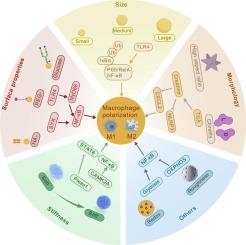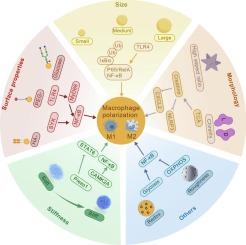Effects of nanoparticle physicochemical properties on macrophage polarization
IF 11.5
1区 医学
Q1 CHEMISTRY, MULTIDISCIPLINARY
引用次数: 0
Abstract
Tumor-associated macrophages (TAMs) are crucial in regulating tumor immune microenvironment (TIME), tumor development and tumor therapy. Nanoparticles, as traditional tumor targeting drug delivery systems, of which the intrinsic immunomodulatory potential has been gradually explored by modulating physicochemical properties. This review systematically summarizes advancements in polarizing macrophages by regulating physicochemical properties of nanoparticles including size, morphology, surface properties, stiffness, and other factors. Furthermore, the polarization mechanisms are expounded via biochemical and mechanical signaling pathways. Size of nanoparticles affects macrophage polarization through lysosomal stress and membrane interaction; morphology of nanoparticles impacts macrophage polarization through inducing membrane curvature or modulating cellular metabolism; surface properties of nanoparticles effects macrophage polarization through enhancing nanoparticle binding ability to cell membrane; stiffness of nanoparticles polarize macrophages through activating mechanosensitive ion channels and inducing deformation of membrane; other properties of nanoparticles effects macrophage polarization via glycolysis, oxidative phosphorylation, etc. These outcomes contribute to the optimization of nanomedicine physicochemical properties for tumor immunotherapy by regulating polarization of TAMs and reshaping the immunosuppressive TIME, thereby driving the development of precision immuno-oncology for various malignancies.


纳米颗粒理化性质对巨噬细胞极化的影响
肿瘤相关巨噬细胞(tumor associated macrophages, tam)在调节肿瘤免疫微环境(TIME)、肿瘤发展和肿瘤治疗中起着至关重要的作用。纳米颗粒作为传统的肿瘤靶向药物递送系统,其内在的免疫调节潜能已通过调节其理化性质逐渐被发掘。本文系统地综述了通过调节纳米颗粒的大小、形态、表面性质、硬度等理化性质来极化巨噬细胞的研究进展。此外,还通过生化和机械信号通路阐述了极化机制。纳米颗粒的大小通过溶酶体应激和膜相互作用影响巨噬细胞极化;纳米颗粒形态通过诱导膜曲率或调节细胞代谢影响巨噬细胞极化;纳米颗粒的表面特性通过增强纳米颗粒与细胞膜的结合能力影响巨噬细胞的极化;纳米颗粒的刚度通过激活机械敏感离子通道和诱导膜变形使巨噬细胞极化;纳米颗粒的其他特性通过糖酵解、氧化磷酸化等作用影响巨噬细胞极化。这些结果有助于通过调节tam的极化和重塑免疫抑制时间来优化肿瘤免疫治疗的纳米药物理化性质,从而推动各种恶性肿瘤的精确免疫肿瘤学的发展。
本文章由计算机程序翻译,如有差异,请以英文原文为准。
求助全文
约1分钟内获得全文
求助全文
来源期刊

Journal of Controlled Release
医学-化学综合
CiteScore
18.50
自引率
5.60%
发文量
700
审稿时长
39 days
期刊介绍:
The Journal of Controlled Release (JCR) proudly serves as the Official Journal of the Controlled Release Society and the Japan Society of Drug Delivery System.
Dedicated to the broad field of delivery science and technology, JCR publishes high-quality research articles covering drug delivery systems and all facets of formulations. This includes the physicochemical and biological properties of drugs, design and characterization of dosage forms, release mechanisms, in vivo testing, and formulation research and development across pharmaceutical, diagnostic, agricultural, environmental, cosmetic, and food industries.
Priority is given to manuscripts that contribute to the fundamental understanding of principles or demonstrate the advantages of novel technologies in terms of safety and efficacy over current clinical standards. JCR strives to be a leading platform for advancements in delivery science and technology.
 求助内容:
求助内容: 应助结果提醒方式:
应助结果提醒方式:


